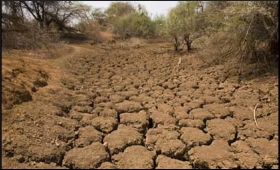|

|
El Nino may impact India's GDP by 1.75 pc: ASSOCHAM
|
|

|
|
| Top Stories |
 |
|
|
|
SME Times News Bureau | 12 May, 2014
The deficit rainfall of 5 percent is due to El Nino factor will cause loss to the GDP of about 1.75 percent i.e. Rs.1,80,000 crore, hurting the lakhs jobs of unskilled sectors, according to the study under taken by ASSOCHAM.
It has been estimated test rise in agriculture by one unit was likely to raise demand for industrial goods by 0.47 and services by 0.12 units and GDP falls 0.35 percent with every one percent deficiency from the average rainfall, reveals the ASSOCHAM study.
The news of drought hitting the economy owing to El Nino factor, the Chamber President Rana Kapoor said, "prima facie is a matter of grave concern". A good harvest results in increased demand for industrial products. Also, good agricultural performance is a must for India to raise demand for services like trade, transport, banking and insurance services.
On the supply side, agricultural inputs are used in the production of various chemical and pharmaceutical products; consumer items, especially non-durable food products, etc. Agriculture provides industry with input such as grains for processed foods, sugarcane for the sugar industry, oilseeds for edible oil industry, cotton for textile industry and so on, said Kapoor.
About 30 percent of the manufacturing sector is agriculture-based. So a bumper crop ensures the supply of raw material for industry at relatively lower prices. To add to this, about 60 percentof net sown area of the country is rain-fed.
The second major implication of the country facing drought is the food inflation vegetable oils and pulses. High rise in the prices of food articles has always been a concern to the policy makers in India, more so during recent years when it has averaged 10 percent during 2008-09 to December 2012. Given that an average household in India still spends almost half of its expenditure on food where as a poor household spends still higher share on food, prolonged spell of high food inflation has caused havoc to their finances. High food inflicts a strong ‘hidden tax’ on the poor, adds the ASSOCHAM paper.
However, on the other side, the projections of monsoons do not point to a very high probability of a drought in 2014-15. Past experiences the ASSOCHAM Chief said indicate that in 2000, 2005 and 2009, agriculture GDP rose despite rains being significantly below average. Also, all El Nino years have not resulted in a drought, although all droughts have happened in years of El Nino.
|
|
|
| |
|
|
|
|
|
|
|
|
|
|
|
|
|
|
| |
| Customs Exchange Rates |
| Currency |
Import |
Export |
US Dollar
|
66.20
|
64.50 |
UK Pound
|
87.50
|
84.65 |
Euro
|
78.25
|
75.65 |
| Japanese
Yen |
58.85 |
56.85 |
| As on 13 Aug, 2022 |
|
|
| Daily Poll |
 |
 |
| PM Modi's recent US visit to redefine India-US bilateral relations |
|
|
|
|
|
| Commented Stories |
 |
|
|
|
|
|
| |
|